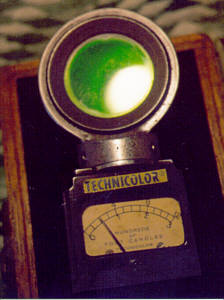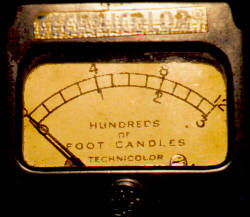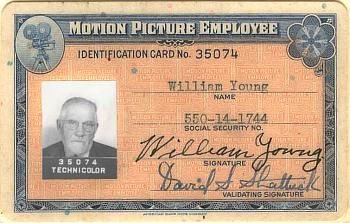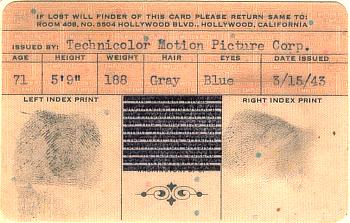




Technicolor, and all competitive color processes, were notoriously "slow". Tremendous amounts of light were required to properly expose color films in the 20's through the 50's. This is a photo of Technicolor meter #27, calibrated in HUNDREDS of footcandles. The meter was manufactured by General Electric. Courtesy of John N. Whittle
The fact that the vast majority of "natural" color processes were two-color does not indicate that film makers and technicians were ignorant of color and what was necessary to present a full palette. Rather it indicates that doing more than two colors was substantially more difficult and the technology was not of sufficient quality to make the considerable extra cost worthwhile. One requisite of any color system that strived for wide appeal was that it had to be a subtractive color process that yielded a strip of film that could be run in the same projectors as conventional black and white film. It was difficult enough to place one color on each side of the film, but there wasn't a third side to accept a blue record, so compromises were made in the form of two-color systems that needed red and green and could fudge a bit on the blue. But even though Hollywood film makers felt that the latest two color version of Technicolor was adequate, and it had provided benefits at the box office, ultimately the film going audience became underwhelmed with color.
But Dr. Kalmus and his staff had developed a reliable method that allowed color records to be placed on top of each other, in the form of dye transfer printing, and thus any number of color records could be applied to one side of the film base. (Competitive systems such as Cinecolor and several others continued to print color records to both sides of the film base into the early 1950s.)
In 1931 Kalmus put the company on the course to develop a three strip camera and to refine the dye transfer printing that had been introduced in 1927. In 1932 the first camera was completed, and it was expensive, costing in excess of $30,000 during a time when the average American wage was less than $.50 per hour.
Many accolades have been put on Dr. Kalmus, but one seldom given would be of salesman extraordinaire. Since its founding in 1915, the company had not earned a profit more than one or two years. Yet he was able, time and again, to approach the stockholders for more money to do the work he felt necessary. In 1932 his perseverance was about to pay off. As studios were almost totally abandoning the production of color films, or even inserts, Kalmus was about to shake them up once again.
At Left - Half of the magic behind GLORIOUS TECHNICOLOR, the venerable 3-strip camera. The film magazine held three reels of specially prepared black and white film. The operation of the 3-strip camera is discussed a bit later. For over 20 years, every color system that was developed, and there were hundreds of them, measured their quality against this machine, and virtually all were patently inferior.
Technicolor had been researching and testing three strip printing for several years and the Doctor felt that the system was ready to be unveiled.

